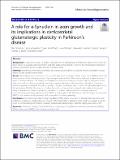A role for α-Synuclein in axon growth and its implications in corticostriatal glutamatergic plasticity in Parkinson’s disease
Author(s)
Schechter, Meir; Grigoletto, Jessica; Abd-Elhadi, Suaad; Glickstein, Hava; Friedman, Alexander; Serrano, Geidy E.; Beach, Thomas G.; Sharon, Ronit; ... Show more Show less
Download13024_2020_Article_370.pdf (5.166Mb)
Publisher with Creative Commons License
Publisher with Creative Commons License
Creative Commons Attribution
Terms of use
Metadata
Show full item recordAbstract
Background
α-Synuclein (α-Syn) is a protein implicated in the pathogenesis of Parkinson’s disease (PD). α-Syn has been shown to associate with membranes and bind acidic phospholipids. However, the physiological importance of these associations to the integrity of axons is not fully clear.
Methods
Biochemical, immunohistochemical and ultrastructural analyses in cultured neurons, transgenic mouse brains, PD and control human brains.
Results
We analyzed the ultrastructure of cross-sectioned axons localized to white matter tracts (WMTs), within the dorsal striatum of old and symptomatic α-Syn transgenic mouse brains. The analysis indicated a higher density of axons of thinner diameter. Our findings in cultured cortical neurons indicate a role for α-Syn in elongation of the main axon and its collaterals, resulting in enhanced axonal arborization. We show that α-Syn effect to enhance axonal outgrowth is mediated through its activity to regulate membrane levels of the acidic phosphatidylinositol 4,5-bisphosphate (PI4,5P2). Moreover, our findings link α-Syn- enhanced axonal growth with evidence for axonal injury. In relevance to disease mechanisms, we detect in human brains evidence for a higher degree of corticostriatal glutamatergic plasticity within WMTs at early stages of PD. However, at later PD stages, the respective WMTs in the caudate are degenerated with accumulation of Lewy pathology.
Conclusions
Our results show that through regulating PI4,5P2 levels, α-Syn acts to elongate the main axon and collaterals, resulting in a higher density of axons in the striatal WMTs. Based on these results we suggest a role for α-Syn in compensating mechanisms, involving corticostriatal glutamatergic plasticity, taking place early in PD.
Date issued
2020-03Department
McGovern Institute for Brain Research at MIT; Massachusetts Institute of Technology. Department of Brain and Cognitive SciencesJournal
Molecular Neurodegeneration
Publisher
Springer Science and Business Media LLC
Citation
Schechter, Meir et al. "A role for α-Synuclein in axon growth and its implications in corticostriatal glutamatergic plasticity in Parkinson’s disease." Molecular Neurodegeneration 15, 1 (March 2020): 24 © 2020 Springer Nature
Version: Final published version
ISSN
1750-1326